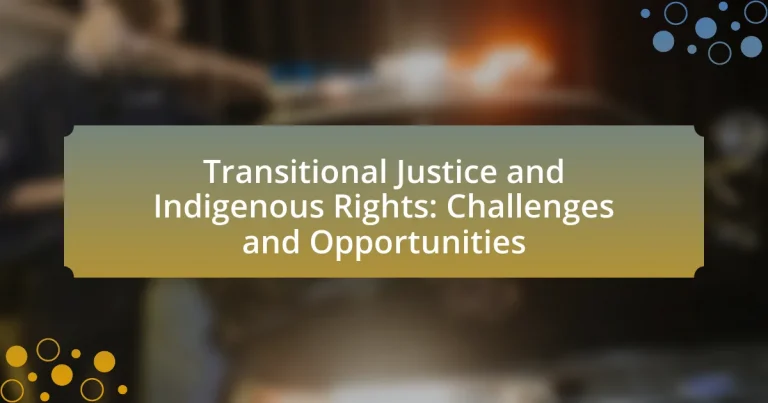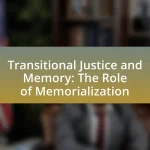Transitional Justice refers to the judicial and non-judicial measures aimed at addressing human rights abuses and fostering accountability, truth, and reconciliation in societies emerging from conflict or authoritarian rule. This article explores the relevance of Transitional Justice to Indigenous Rights, emphasizing its potential to rectify historical injustices such as land dispossession and cultural erasure. Key principles of Transitional Justice, including truth-telling, reparations, accountability, and participation, are examined in relation to Indigenous communities. The article also discusses the challenges faced in implementing these mechanisms, the importance of recognizing Indigenous rights, and the role of Indigenous voices in shaping effective Transitional Justice frameworks. Additionally, it highlights successful case studies and best practices that can enhance Indigenous rights through inclusive and culturally sensitive approaches.
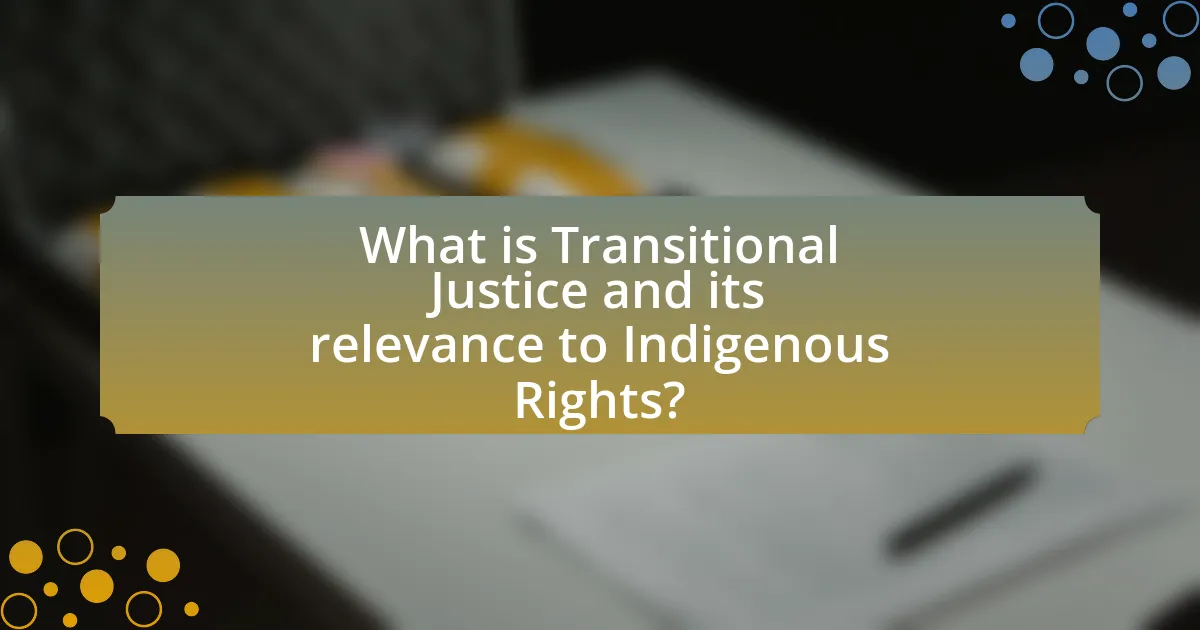
What is Transitional Justice and its relevance to Indigenous Rights?
Transitional Justice refers to the set of judicial and non-judicial measures implemented to address legacies of human rights abuses and promote accountability, truth, and reconciliation in societies transitioning from conflict or authoritarian rule. Its relevance to Indigenous Rights lies in its potential to rectify historical injustices faced by Indigenous peoples, such as land dispossession, cultural erasure, and systemic discrimination. For instance, the United Nations Declaration on the Rights of Indigenous Peoples emphasizes the importance of recognizing Indigenous rights in transitional justice processes, highlighting that addressing past wrongs is essential for fostering genuine reconciliation and ensuring the protection of Indigenous identities and cultures.
How does Transitional Justice address historical injustices faced by Indigenous peoples?
Transitional Justice addresses historical injustices faced by Indigenous peoples by implementing mechanisms that promote accountability, reparations, and reconciliation. These mechanisms often include truth commissions, which document past abuses and acknowledge the suffering of Indigenous communities, thereby validating their experiences. For instance, the Truth and Reconciliation Commission of Canada specifically addressed the impacts of residential schools on Indigenous peoples, leading to public acknowledgment and policy changes aimed at redressing these historical wrongs. Additionally, reparative measures, such as land restitution and financial compensation, are integral to restoring Indigenous rights and fostering healing. This approach not only seeks to rectify past injustices but also aims to empower Indigenous communities in shaping their future.
What are the key principles of Transitional Justice in relation to Indigenous rights?
The key principles of Transitional Justice in relation to Indigenous rights include truth-telling, reparations, accountability, and participation. Truth-telling involves acknowledging historical injustices faced by Indigenous peoples, such as colonization and cultural erasure, which is essential for healing and reconciliation. Reparations focus on compensating Indigenous communities for past harms, including land restitution and financial support, as recognized in various international frameworks like the United Nations Declaration on the Rights of Indigenous Peoples. Accountability ensures that perpetrators of human rights violations against Indigenous peoples are held responsible, fostering a sense of justice and deterrence against future abuses. Lastly, participation emphasizes the need for Indigenous voices to be included in decision-making processes regarding their rights and the implementation of transitional justice measures, aligning with principles of self-determination and respect for Indigenous sovereignty. These principles collectively aim to address historical grievances and promote a more equitable future for Indigenous communities.
How do different countries implement Transitional Justice for Indigenous communities?
Different countries implement Transitional Justice for Indigenous communities through various mechanisms, including truth commissions, reparations, and legal reforms. For instance, Canada established the Truth and Reconciliation Commission to address the legacy of residential schools, which aimed to document the experiences of Indigenous peoples and recommend actions for healing and reparations. Similarly, Australia has engaged in processes like the Bringing Them Home report, which focused on the Stolen Generations and recommended reparations and acknowledgment of past injustices. In New Zealand, the Waitangi Tribunal investigates breaches of the Treaty of Waitangi, providing a platform for Indigenous claims and facilitating settlements. These examples illustrate how countries tailor their Transitional Justice approaches to address historical grievances and promote reconciliation with Indigenous communities.
Why is the recognition of Indigenous rights crucial in Transitional Justice processes?
The recognition of Indigenous rights is crucial in Transitional Justice processes because it addresses historical injustices and promotes healing for Indigenous communities. Acknowledging these rights ensures that Indigenous voices are included in the justice process, which is essential for achieving genuine reconciliation. For instance, the United Nations Declaration on the Rights of Indigenous Peoples emphasizes the importance of respecting Indigenous rights in all justice initiatives, highlighting that failure to do so can perpetuate cycles of violence and marginalization. Furthermore, studies have shown that inclusive Transitional Justice mechanisms that recognize Indigenous rights lead to more sustainable peace and social cohesion, as they validate the experiences and claims of Indigenous peoples, fostering trust in the justice system.
What role do Indigenous voices play in shaping Transitional Justice frameworks?
Indigenous voices play a crucial role in shaping Transitional Justice frameworks by ensuring that their unique perspectives, experiences, and rights are recognized and integrated into justice processes. Their involvement helps to address historical injustices, promote accountability, and foster reconciliation in a manner that respects Indigenous cultures and traditions. For instance, the United Nations Declaration on the Rights of Indigenous Peoples emphasizes the importance of Indigenous participation in decision-making processes that affect them, which is essential for effective Transitional Justice. This integration not only validates Indigenous experiences but also enhances the legitimacy and effectiveness of justice mechanisms by making them more inclusive and culturally relevant.
How can Indigenous rights enhance the effectiveness of Transitional Justice initiatives?
Indigenous rights can enhance the effectiveness of Transitional Justice initiatives by ensuring that the unique historical and cultural contexts of Indigenous communities are recognized and addressed. When Indigenous rights are integrated into Transitional Justice processes, it fosters inclusivity and promotes healing by acknowledging past injustices, such as land dispossession and cultural erasure. For instance, the United Nations Declaration on the Rights of Indigenous Peoples emphasizes the importance of participation and self-determination, which can lead to more meaningful reparations and reconciliation efforts. Studies have shown that when Indigenous perspectives are included, the legitimacy and acceptance of Transitional Justice measures increase, ultimately leading to more sustainable peace and social cohesion.
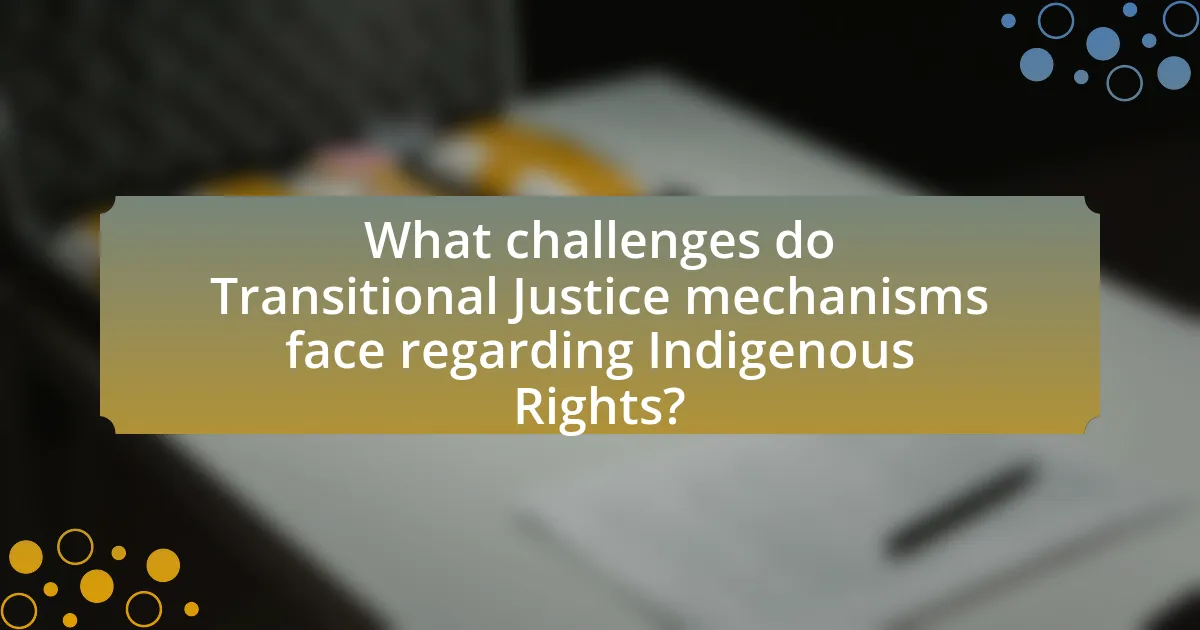
What challenges do Transitional Justice mechanisms face regarding Indigenous Rights?
Transitional Justice mechanisms face significant challenges regarding Indigenous Rights, primarily due to historical injustices and systemic marginalization of Indigenous communities. These mechanisms often struggle to adequately address the unique cultural, social, and legal needs of Indigenous peoples, leading to insufficient recognition of their rights and voices in the justice process. For instance, the Truth and Reconciliation Commission in Canada highlighted that many Indigenous individuals felt excluded from the process, which undermined the effectiveness of reconciliation efforts. Additionally, the lack of legal frameworks that specifically protect Indigenous rights during transitional justice processes often results in the perpetuation of existing inequalities, as seen in various countries where Indigenous land rights and self-determination are not prioritized.
What are the common obstacles in implementing Transitional Justice for Indigenous peoples?
Common obstacles in implementing Transitional Justice for Indigenous peoples include lack of political will, inadequate legal frameworks, and insufficient community involvement. Political will is often absent due to historical marginalization and ongoing discrimination against Indigenous communities, which hinders the commitment of governments to address injustices. Legal frameworks frequently fail to recognize Indigenous rights and sovereignty, limiting the effectiveness of transitional justice mechanisms. Additionally, the lack of meaningful participation from Indigenous peoples in the design and implementation of transitional justice processes leads to solutions that do not reflect their needs or perspectives, further perpetuating feelings of exclusion and mistrust.
How do systemic inequalities impact Transitional Justice efforts for Indigenous communities?
Systemic inequalities significantly hinder Transitional Justice efforts for Indigenous communities by perpetuating marginalization and limiting access to justice. These inequalities manifest in various forms, such as socio-economic disparities, historical injustices, and lack of political representation, which collectively undermine Indigenous voices in the justice process. For instance, Indigenous populations often face barriers in legal systems that are not culturally sensitive or accessible, leading to underrepresentation in transitional justice mechanisms. Research indicates that in countries like Canada and Australia, systemic discrimination has resulted in inadequate reparations and recognition of Indigenous rights, further entrenching cycles of injustice. Thus, addressing these systemic inequalities is crucial for effective Transitional Justice that genuinely serves Indigenous communities.
What are the limitations of existing legal frameworks in addressing Indigenous rights?
Existing legal frameworks often fail to adequately address Indigenous rights due to their limited recognition of Indigenous sovereignty and cultural practices. Many national laws prioritize state interests over Indigenous claims, leading to inadequate protection of land rights and self-determination. For instance, the United Nations Declaration on the Rights of Indigenous Peoples, while a significant step, lacks binding enforcement mechanisms, allowing states to selectively implement its provisions. Additionally, legal definitions of land ownership often do not align with Indigenous concepts of communal land stewardship, resulting in conflicts and marginalization. These limitations highlight the need for legal reforms that genuinely incorporate Indigenous perspectives and rights into national and international law.
How do cultural differences affect Transitional Justice processes for Indigenous peoples?
Cultural differences significantly affect Transitional Justice processes for Indigenous peoples by influencing their perceptions of justice, reconciliation, and healing. Indigenous communities often prioritize restorative justice approaches that align with their cultural values, such as community involvement and traditional practices, rather than punitive measures typically favored in Western legal systems. For instance, the Truth and Reconciliation Commission in Canada recognized the importance of Indigenous cultural practices in addressing historical injustices, which included ceremonies and storytelling as vital components of the healing process. This cultural emphasis can lead to tensions when state-led Transitional Justice mechanisms do not adequately incorporate Indigenous perspectives, potentially undermining the legitimacy and effectiveness of these processes.
What cultural considerations must be taken into account in Transitional Justice?
Cultural considerations in Transitional Justice include the recognition of diverse cultural identities, the importance of traditional practices, and the need for inclusive dialogue. These elements are crucial because they ensure that justice processes resonate with affected communities and respect their values. For instance, in many Indigenous cultures, healing and reconciliation may involve community-led ceremonies rather than formal legal proceedings. Acknowledging these cultural frameworks can enhance the legitimacy and effectiveness of Transitional Justice initiatives, as evidenced by cases in countries like Canada, where Indigenous perspectives have been integrated into reconciliation efforts following historical injustices.
How can cultural sensitivity improve Transitional Justice outcomes for Indigenous communities?
Cultural sensitivity can significantly improve Transitional Justice outcomes for Indigenous communities by fostering trust and ensuring that justice processes are aligned with Indigenous values and practices. When Transitional Justice mechanisms incorporate cultural sensitivity, they acknowledge the unique historical and social contexts of Indigenous peoples, which can lead to more meaningful engagement and participation in the justice process. For example, the Truth and Reconciliation Commission in Canada emphasized the importance of Indigenous perspectives, which resulted in a more inclusive approach that recognized the harms experienced by Indigenous communities. This approach not only validates their experiences but also enhances the legitimacy of the justice process, ultimately leading to better reconciliation outcomes.
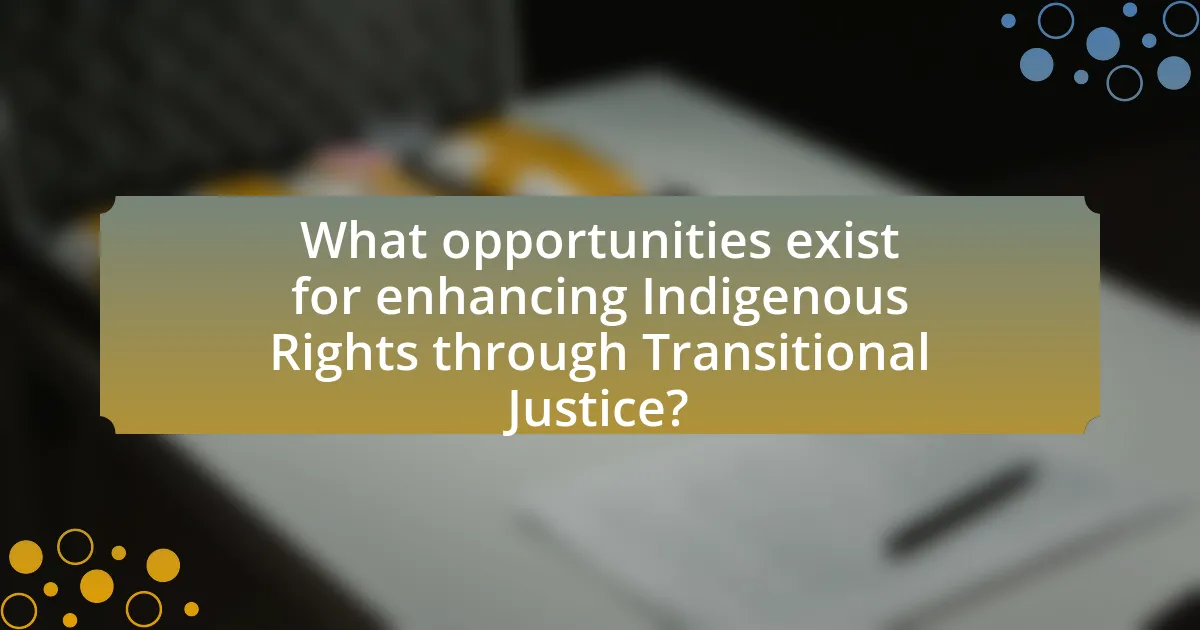
What opportunities exist for enhancing Indigenous Rights through Transitional Justice?
Transitional justice provides opportunities for enhancing Indigenous rights by promoting accountability, reparations, and recognition of historical injustices. These mechanisms can facilitate the acknowledgment of past wrongs against Indigenous communities, such as land dispossession and cultural erasure, thereby fostering healing and reconciliation. For instance, the Truth and Reconciliation Commission in Canada has highlighted the need for reparative measures and has led to policy changes aimed at recognizing Indigenous sovereignty and rights. Additionally, transitional justice frameworks can empower Indigenous voices in decision-making processes, ensuring their participation in shaping policies that affect their communities. This participatory approach is essential for addressing systemic inequalities and promoting social justice for Indigenous peoples.
How can Transitional Justice promote healing and reconciliation for Indigenous peoples?
Transitional Justice can promote healing and reconciliation for Indigenous peoples by addressing historical injustices and facilitating dialogue between Indigenous communities and the state. This process often includes truth commissions, reparations, and acknowledgment of past wrongs, which can validate Indigenous experiences and foster a sense of justice. For instance, the Truth and Reconciliation Commission of Canada documented the impacts of residential schools on Indigenous communities, providing a platform for survivors to share their stories and seek acknowledgment. Such initiatives can lead to restorative practices that empower Indigenous peoples, rebuild trust, and create pathways for healing, ultimately contributing to social cohesion and mutual respect.
What successful case studies demonstrate the positive impact of Transitional Justice on Indigenous rights?
Successful case studies demonstrating the positive impact of Transitional Justice on Indigenous rights include the Truth and Reconciliation Commission (TRC) in Canada and the National Commission on Truth and Reconciliation in South Africa. The TRC in Canada, established in 2008, aimed to address the legacy of residential schools and promote healing for Indigenous communities. It resulted in public acknowledgment of injustices, recommendations for reparations, and a commitment to implement Indigenous rights in policy-making. The TRC’s final report highlighted over 94 Calls to Action, many of which focus on Indigenous rights and reconciliation.
In South Africa, the National Commission on Truth and Reconciliation, active from 1996 to 1998, addressed human rights violations during apartheid, including those affecting Indigenous populations. The commission’s work led to public testimonies, reparations for victims, and a framework for recognizing Indigenous rights within the new democratic constitution. This process fostered national dialogue and contributed to the legal recognition of Indigenous land rights.
Both case studies illustrate how Transitional Justice mechanisms can facilitate acknowledgment, reparations, and policy changes that positively impact Indigenous rights.
How can collaboration with Indigenous leaders strengthen Transitional Justice initiatives?
Collaboration with Indigenous leaders can strengthen Transitional Justice initiatives by ensuring that these processes are culturally relevant and inclusive of Indigenous perspectives. Engaging Indigenous leaders allows for the incorporation of traditional knowledge and practices, which can enhance the legitimacy and effectiveness of justice mechanisms. For instance, the Truth and Reconciliation Commission in Canada highlighted the importance of Indigenous voices in addressing historical injustices, leading to recommendations that reflect Indigenous values and experiences. This collaboration fosters trust and promotes healing within communities, ultimately contributing to more sustainable and equitable outcomes in Transitional Justice efforts.
What role does education play in advancing Transitional Justice and Indigenous rights?
Education plays a crucial role in advancing Transitional Justice and Indigenous rights by fostering awareness, understanding, and advocacy among individuals and communities. It equips learners with knowledge about historical injustices faced by Indigenous peoples, such as colonization and cultural erasure, which are essential for recognizing the need for justice and reparative measures. For instance, educational programs that include Indigenous history and perspectives can promote empathy and support for policies aimed at reconciliation and restitution. Furthermore, research indicates that education can empower Indigenous communities to assert their rights and engage in legal and political processes, as seen in various successful Indigenous-led initiatives worldwide.
How can awareness campaigns improve understanding of Indigenous issues in Transitional Justice?
Awareness campaigns can significantly enhance understanding of Indigenous issues in Transitional Justice by educating the public about historical injustices and current challenges faced by Indigenous communities. These campaigns often utilize storytelling, visual media, and community engagement to convey the lived experiences of Indigenous peoples, fostering empathy and awareness. For instance, the Truth and Reconciliation Commission of Canada highlighted the importance of public education in addressing the legacy of residential schools, which has been crucial in shaping societal perceptions and promoting dialogue. By disseminating accurate information and encouraging discussions, awareness campaigns can bridge gaps in knowledge and promote a more inclusive approach to Transitional Justice that recognizes and respects Indigenous rights and perspectives.
What educational resources are available to support Indigenous rights in Transitional Justice contexts?
Educational resources available to support Indigenous rights in Transitional Justice contexts include academic publications, online courses, and community workshops. For instance, the United Nations Declaration on the Rights of Indigenous Peoples (UNDRIP) serves as a foundational document that outlines the rights of Indigenous peoples and is often used in educational settings to inform discussions on transitional justice. Additionally, organizations like the International Center for Transitional Justice provide resources and training materials that focus on integrating Indigenous perspectives into transitional justice processes. These resources are crucial for understanding the unique challenges faced by Indigenous communities and for promoting their rights within transitional justice frameworks.
What best practices can be adopted for effective Transitional Justice regarding Indigenous Rights?
Effective Transitional Justice regarding Indigenous Rights can be achieved through inclusive participation, recognition of Indigenous sovereignty, and the establishment of reparative measures. Inclusive participation ensures that Indigenous communities are actively involved in the decision-making processes, which is crucial for legitimacy and effectiveness. Recognition of Indigenous sovereignty acknowledges their rights to self-determination and governance, which is essential for restoring trust and fostering reconciliation. Establishing reparative measures, such as land restitution and financial compensation, addresses historical injustices and supports healing within Indigenous communities. These practices are supported by frameworks like the United Nations Declaration on the Rights of Indigenous Peoples, which emphasizes the importance of Indigenous participation and rights in transitional justice processes.
How can stakeholder engagement be optimized in Transitional Justice processes?
Stakeholder engagement in Transitional Justice processes can be optimized by implementing inclusive dialogue mechanisms that ensure diverse voices are heard. This approach fosters trust and collaboration among affected communities, government entities, and civil society organizations. For instance, the United Nations emphasizes the importance of participatory approaches in its guidelines for Transitional Justice, highlighting that inclusive processes lead to more sustainable outcomes and greater legitimacy. Additionally, utilizing technology for remote consultations can enhance participation, especially for marginalized groups, thereby increasing the overall effectiveness of the engagement strategy.
What strategies can ensure the sustainability of Transitional Justice initiatives for Indigenous communities?
To ensure the sustainability of Transitional Justice initiatives for Indigenous communities, it is essential to incorporate community-led approaches that prioritize Indigenous voices and perspectives. Engaging Indigenous leaders and stakeholders in the design and implementation of these initiatives fosters ownership and relevance, which are critical for long-term success. Research indicates that initiatives that are culturally sensitive and aligned with Indigenous values are more likely to be embraced and sustained by the community (UNESCO, 2019). Furthermore, establishing legal frameworks that protect Indigenous rights and integrating transitional justice mechanisms into existing governance structures can enhance accountability and support ongoing efforts. These strategies collectively contribute to the resilience and sustainability of Transitional Justice initiatives within Indigenous contexts.
